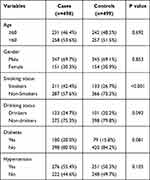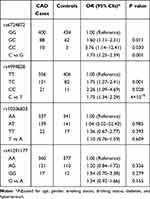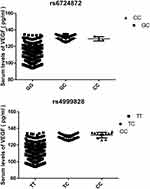Back to Journals » Pharmacogenomics and Personalized Medicine » Volume 14
Association of Genetic Variants in miR-217 Gene with Risk of Coronary Artery Disease: A Case–Control Study
Authors Han X, Liang X, Wu M, Zhang L, Jiang H
Received 14 June 2021
Accepted for publication 15 August 2021
Published 28 August 2021 Volume 2021:14 Pages 1081—1086
DOI https://doi.org/10.2147/PGPM.S324767
Checked for plagiarism Yes
Review by Single anonymous peer review
Peer reviewer comments 2
Editor who approved publication: Dr Martin H Bluth
Xia Han,1,* Xiaotang Liang,2,* Menghai Wu,1 Lijun Zhang,1 Honglei Jiang2
1Department of Cardiology, Jinan People’s Hospital Affiliated to Shandong First Medical University, Laiwu, 271199, People’s Republic of China; 2Shandong Second Provincial General Hospital, Jinan, Shandong Province, 250000, People’s Republic of China
*These authors contributed equally to this work
Correspondence: Honglei Jiang
Shandong Second Provincial General Hospital, No. 4, Xingxi Street, Jinan, Shandong Province, 250000, People’s Republic of China
Email [email protected]
Objective: To evaluate the associations of genetic variants of the miR-217 gene with coronary artery disease (CAD) risk, as well as plasma level of vascular endothelial growth factor (VEGF).
Methods: A case–control study with 498 CAD patients and 499 frequency-matched healthy controls was conducted to evaluate the associations of four tagSNPs of the miR-217 gene, including rs6724872, rs4999828, rs10206823, and rs41291177, with CAD risk and plasma level of VEGF.
Results: SNP rs6724872 and rs4999828 were significantly associated with increased risk of CAD (P value was smaller than 0.05 even after Bonferroni multiple adjustment). Compared with the G allele, C allele of rs6724872 was significantly associated with 1.73-fold increased risk of CAD (95% CI: 1.25– 2.39; P = 0.001). While C allele of rs4999828 was significantly associated with 1.75-fold increased risk of CAD, compared with T allele (95% CI: 1.34– 2.29; P = 4 × 10− 5). Meanwhile, rs6724872 and rs4999828 were also significantly associated with higher level of VEGF (P < 0.001).
Conclusion: These findings highlighted the important role of genetic variants of the miR-217 gene in the pathogenesis of CAD and potential targets for intervention.
Keywords: coronary artery disease, miR-217, VEGF, genetic
Introduction
Coronary artery disease (CAD) is the major cause of death throughout the world.1 As reported by GBD 2017 Causes of Death Collaborators, the estimated years of life lost (YLLs) increased for CAD (ranked first in 2017).2 During the past decade, a marked rising trend of atherosclerosis-related burden (especially for CAD) in Eastern Asia was observed.3 Although endothelial dysfunction contributes essentially to the atherosclerosis, the molecular pathways underlying disease occurrence are not fully understood.
MicroRNAs (miRNAs) play important roles in the pathophysiology of cardiovascular diseases through the posttranscriptional control of gene networks.4,5 Among them, miR-217 was reported to aggravate atherosclerosis and promote cardiovascular dysfunction through downregulating a network of endothelial NO synthase (eNOS) activators, including vascular endothelial growth factor (VEGF).6 VEGF, a signal protein stimulating the formation of blood vessels, acted as a potential biomarker to predict the occurrence of CAD, and increased VEGF level was associated with poor coronary collateralization in patients with stable CAD.7 Besides, inhibition of miR-217 could protect against myocardial ischemia-reperfusion injury through inactivating NF-kappaB and MAPK pathways by targeting DUSP14.8 These findings highlighted a potential role of miR-217 in pathogenesis of CAD. Whether genetic variants of the miR-217 gene contributed to the occurrence of CAD was still undetermined and worthy to be explored. Thus, we aimed to conduct a case–control study among Chinese population to evaluate the associations of genetic variants of the miR-217 gene with CAD risk, as well as plasma level of VEGF.
Patients and Methods
Study Subjects
In the current case–control study, we totally recruited 498 CAD patients and 499 healthy controls (frequency-matched by age, gender, and living areas). CAD diagnosis of any major coronary artery with diameter stenosis of more than 50%, or previous angioplasty, coronary bypass surgery, or myocardial infarction (MI) history verified by electrocardiogram (ECG) changes was evaluated by two cardiologists.9 This study has been approved by the institute committee of Jinan people’s Hospital. All participants in the study received informed consent and followed the guidelines set out in the Helsinki declaration.
Blood Sampling and Measurement
Fasting venous blood was collected into plasma tubes containing 0.1% ethylenediaminetetraacetic acid (EDTA) and stored at −80°C prior to analysis. Total RNAs were isolated using the miRNeasy kit (Qiagen) according to the manufacturer’s protocol. TaqMan miRNA assay kits (Applied Biosystems) were used for miRNA amplification, and real-time polymerase chain reaction (RT-PCR) was performed to detect miR-217, while cel-miRNA-39 was added as a spike-in control. Plasma VEGF level among the healthy controls was determined by multiplex analysis using Bioplex suspension arrays (Bio-Rad, Veenendaal, The Netherlands) according to the manufacturer’s specifications. All samples were thawed only once and measured three times.
TagSNP Selection, DNA Extraction and Genotyping
TagSNPs were selected among the 1kb flanking region of the miR-217 gene according to 1000 genome CHB data (phase 3, minor allele frequency ≥5%, pairwise r2≥0.8) using the Haploview 4.2 software.10 Finally, four tagSNPs, including rs6724872, rs4999828, rs10206823, and rs41291177, were determined. Genomic DNA was extracted from peripheral blood samples using QIAamp DNA blood Mini Kit (Qiagen, Hilden, Germany). Genotyping was performed by TaqMan analysis (Applied Biosystems [ABI], Foster City, CA) according to the manufacturer’s instructions. A randomly selected group of 10% of the samples was tested twice by different individuals with 100% concordance of results.
Statistical Analysis
Statistical analyses were carried out using IBM SPSS Statistics version 22.0, while two-tailed P-values <0.05 were considered significant. All the demographic data were presented as proportions. Deviation of candidate SNPs from Hardy-Weinberg equilibrium in the control group was assessed by the goodness-of-fit χ2 test. Allele frequencies and demographic variables between the two groups were assessed with chi-square tests. Odds ratios (ORs), 95% confidence levels (CIs), and corresponding P values were calculated for each SNP using logistic regression analysis, adjusted for age, gender, smoking status, drinking status, diabetes, and hypertension.
Results
Characteristics of Study Subjects
Table 1 lists the comparison of clinical features between 498 CAD cases and 499 controls. The results showed that there was no significant difference in age, gender, drinking status, diabetes and hypertension (P > 0.05). However, compared with the control group, the patients have higher percentage of smokers (controls vs cases: 26.7% vs 42.4%; P < 0.001).
 |
Table 1 Clinical Characteristics of CAD Cases and Controls |
Plasma Level of miR-217 and CAD Risk
We first evaluated the association between plasma level of miR-217 and CAD risk to validate the role of miR-217 in CAD development. As shown in Figure 1, plasma level of miR-217 was analyzed in 50 randomly selected patients with CAD and controls. We found plasma level of miR-217 in CAD cases was significantly higher than that in controls (P < 0.001).
Genetic Associations of Candidate tagSNPs with CAD Risk
As shown in Table 2, all four tagSNPs (rs6724872, rs4999828, rs10206823, and rs41291177) were in Hardy-Weinberg equilibrium in healthy controls, which indicated that the sampled subjects were representative of the population without any deviation of genotype frequencies (P > 0.05). Of the four tagSNPs in the miR-217 gene region, rs6724872 and rs4999828 were significantly associated with increased risk of CAD (P value was smaller than 0.05 even after Bonferroni multiple adjustment). Compared with the G allele, C allele of rs6724872 was significantly associated with 1.73-fold increased risk of CAD (95% CI: 1.25–2.39; P=0.001). While C allele of rs4999828 was significantly associated with 1.75-fold increased risk of CAD, compared with T allele (95% CI: 1.34–2.29; P=4×10−5).
 |
Table 2 Associations Between Genetic Variations and Risk of CAD |
Plasma VEGF Level with Different Genotypes of rs6724872 and rs4999828
To further evaluate the influence of susceptibility SNPs upon plasma level of VEGF, we compared the VEGF level among healthy controls with different genotypes of rs6724872 and rs4999828. As shown in Figure 2, with the increase in number of minor alleles, the plasma level of VEGF increased significantly for both rs6724872 and rs4999828 (P < 0.001). This means rs6724872 and rs4999828 were significantly associated with higher level of VEGF.
Discussion
Coronary heart disease is a common and frequent disease, which brings serious trouble to people’s quality of life.2,11 The exploration of the etiology of CAD is a complex and systematic project, and researchers have explored multiple aspects and perspectives.12,13 The current study explored associations between the associations of genetic variants of the miR-217 gene with CAD risk, as well as plasma level of VEGF, using a case–control study design. We found plasma level of miR-217, rs6724872 and rs4999828 were significantly associated with increased risk of CAD, as well as higher level of VEGF. These findings highlighted the important role of miR-217 in the pathogenesis of CAD and potential targets for intervention.
MiRNAs are implicated in the regulation of proliferation and apoptosis of endothelial cells, induction of immune responses and different stages of plaque formation, which finally results atherosclerosis and CAD.5,14,15 A previous meta-analysis identified that a total of 48 dysregulated miRNAs were confirmed for their role in CAD development, while MiR-122-5p and miR-133a-3p may be valuable biomarkers for CAD.16 Another two studies confirmed that predictive value of miRNA-21 and miRNA-126 on coronary restenosis after percutaneous coronary intervention (PCI) in patients with CAD.17,18 Previously, miR-217 was most studied in the field of cancer biology.19–23 Zhao et al reported that downregulated miR-217 could regulate KRAS and function as a tumor suppressor in pancreatic ductal adenocarcinoma (PDAC).19 Further, Menghini et al pinpointed miR-217 as an endogenous inhibitor of SirT1 was potentially amenable to the prevention of endothelial dysfunction.24 Recently, Yebenes then reported that miR-217 could aggravate atherosclerosis and promote cardiovascular dysfunction.6 Taking the findings above together, it is important to extensively explore the role of miR-217 in the pathogenesis of CAD and to investigate the association of its genetic variants with the risk of disease development.
Genetic variants in miRNAs have been widely explored for their functions among pathophysiological mechanism of cardiovascular diseases, and offer new insight into the causal role of microRNAs in CAD.25–31 Glinsky et al revealed identifies a consensus disease phenocode through a SNP-guided microRNA map of fifteen common human disorders.31 Ghanbari et al systematically evaluated 230 variants located within miRNA-binding sites in the 3ʹ-untranslated region of 155 cardiometabolic genes, and 37 were functional in their corresponding genomic loci.28 In the current study, rs6724872 and rs4999828 were significantly associated with increased risk of CAD, as well as higher level of VEGF, which means the important role in CAD development. Using RegulomeDB 2.0, we found both rs6724872 and rs4999828 were located in the TF binding and DNase peak region.32 The findings of HaploReg v4.1 also validated their functions in gene regulation.33
Conclusively, We found rs6724872 and rs4999828 were significantly associated with increased risk of CAD, as well as higher level of VEGF. Although these findings need further validation in larger cohorts for definitive results, they reveal new mechanisms by which genetic variations in miR-217 gene may coordinate the development of CAD. The gathered evidence could be further exploited in prevention strategies or screening protocols for CAD.
Acknowledgment
This study was supported by medical and health science and technology development planning project of Shandong Province (No. 202003011008) and the second batch of science and technology projects of Jinan Health Committee (2020-03-55).
Disclosure
The authors declare that they have no conflict of interest.
References
1. Hata J, Kiyohara Y. Epidemiology of stroke and coronary artery disease in Asia. Circ J. 2013;77(8):1923–1932. doi:10.1253/circj.CJ-13-0786
2. Collaborators GBDCoD. Global, regional, and national age-sex-specific mortality for 282 causes of death in 195 countries and territories, 1980–2017: a systematic analysis for the Global Burden of Disease Study 2017. Lancet. 2018;392(10159):1736–1788.
3. Wong MC, Zhang DX, Wang HH. Rapid emergence of atherosclerosis in Asia: a systematic review of coronary atherosclerotic heart disease epidemiology and implications for prevention and control strategies. Curr Opin Lipidol. 2015;26(4):257–269. doi:10.1097/MOL.0000000000000191
4. Widmer RJ, Lerman LO, Lerman A. MicroRNAs: small molecule, big potential for coronary artery disease. Eur Heart J. 2016;37(22):1750–1752. doi:10.1093/eurheartj/ehw067
5. Ghafouri-Fard S, Gholipour M, Taheri M. Role of MicroRNAs in the pathogenesis of coronary artery disease. Front Cardiovasc Med. 2021;8:632392. doi:10.3389/fcvm.2021.632392
6. de Yebenes VG, Briones AM, Martos-Folgado I, et al. Aging-associated miR-217 aggravates atherosclerosis and promotes cardiovascular dysfunction. Arterioscler Thromb Vasc Biol. 2020;40(10):2408–2424. doi:10.1161/ATVBAHA.120.314333
7. Sun Z, Shen Y, Lu L, et al. Increased serum level of soluble vascular endothelial growth factor receptor-1 is associated with poor coronary collateralization in patients with stable coronary artery disease. Circ J. 2014;78(5):1191–1196. doi:10.1253/circj.CJ-13-1143
8. Li Y, Fei L, Wang J, Niu Q. Inhibition of miR-217 protects against myocardial ischemia-reperfusion injury through inactivating NF-kappaB and MAPK pathways. Cardiovasc Eng Technol. 2020;11(2):219–227. doi:10.1007/s13239-019-00452-z
9. Li J, Zhang Y, Guo X, Wu Y, Huang R, Han X. Circulating level of monocyte chemoattractant protein-1 and risk of coronary artery disease: a case-control and Mendelian randomization study. Pharmgenomics Pers Med. 2021;14:553–559.
10. Barrett JC. Haploview: visualization and analysis of SNP genotype data. Cold Spring Harb Protoc. 2009;2009(10):pdbip71. doi:10.1101/pdb.ip71
11. Benjamin EJ, Blaha MJ, Chiuve SE, et al. Heart disease and stroke statistics-2017 update: a report from the American Heart Association. Circulation. 2017;135(10):e146–e603.
12. Manfrini O, Yoon J, van der Schaar M, et al. Sex differences in modifiable risk factors and severity of coronary artery disease. J Am Heart Assoc. 2020;9(19):e017235. doi:10.1161/JAHA.120.017235
13. Lonnebakken MT. Cardiometabolic risk factors and coronary artery disease in women. J Womens Health (Larchmt). 2020;29(12):1489–1490. doi:10.1089/jwh.2020.8755
14. Sanlialp M, Dodurga Y, Uludag B, et al. Peripheral blood mononuclear cell microRNAs in coronary artery disease. J Cell Biochem. 2020;121(4):3005–3009. doi:10.1002/jcb.29557
15. Zhang X, Cai H, Zhu M, Qian Y, Lin S, Li X. Circulating microRNAs as biomarkers for severe coronary artery disease. Medicine (Baltimore). 2020;99(17):e19971. doi:10.1097/MD.0000000000019971
16. Wang -S-S, Wu L-J, Li -J-J-H, Xiao H-B, He Y, Yan Y-X. A meta-analysis of dysregulated miRNAs in coronary heart disease. Life Sci. 2018;215:170–181. doi:10.1016/j.lfs.2018.11.016
17. Dai H, Wang J, Shi Z, Ji X, Huang Y, Zhou R. Predictive value of miRNA-21 on coronary restenosis after percutaneous coronary intervention in patients with coronary heart disease: a protocol for systematic review and meta-analysis. Medicine (Baltimore). 2021;100(10):e24966. doi:10.1097/MD.0000000000024966
18. Qiu X, Wang J, Shi Z, Ji X, Huang Y, Dai H. Predictive value of miRNA-126 on in-stent restenosis in patients with coronary heart disease: a protocol for meta-analysis and bioinformatics analysis. Medicine (Baltimore). 2021;100(22):e25887. doi:10.1097/MD.0000000000025887
19. Zhao WG, Yu SN, Lu ZH, Ma YH, Gu YM, Chen J. The miR-217 microRNA functions as a potential tumor suppressor in pancreatic ductal adenocarcinoma by targeting KRAS. Carcinogenesis. 2010;31(10):1726–1733. doi:10.1093/carcin/bgq160
20. Deng S, Zhu S, Wang B, et al. Chronic pancreatitis and pancreatic cancer demonstrate active epithelial-mesenchymal transition profile, regulated by miR-217-SIRT1 pathway. Cancer Lett. 2014;355(2):184–191. doi:10.1016/j.canlet.2014.08.007
21. Nishioka C, Ikezoe T, Yang J, Nobumoto A, Tsuda M, Yokoyama A. Downregulation of miR-217 correlates with resistance of Ph(+) leukemia cells to ABL tyrosine kinase inhibitors. Cancer Sci. 2014;105(3):297–307. doi:10.1111/cas.12339
22. Popov A, Szabo A, Mandys V. Small nucleolar RNA U91 is a new internal control for accurate microRNAs quantification in pancreatic cancer. BMC Cancer. 2015;15:774. doi:10.1186/s12885-015-1785-9
23. Xi S, Inchauste S, Guo H, et al. Cigarette smoke mediates epigenetic repression of miR-217 during esophageal adenocarcinogenesis. Oncogene. 2015;34(44):5548–5559. doi:10.1038/onc.2015.10
24. Menghini R, Casagrande V, Cardellini M, et al. MicroRNA 217 modulates endothelial cell senescence via silent information regulator 1. Circulation. 2009;120(15):1524–1532. doi:10.1161/CIRCULATIONAHA.109.864629
25. Borghini A, Andreassi MG. Genetic polymorphisms offer insight into the causal role of microRNA in coronary artery disease. Atherosclerosis. 2018;269:63–70. doi:10.1016/j.atherosclerosis.2017.12.022
26. Joehanes R, Zhang X, Huan T, et al. Integrated genome-wide analysis of expression quantitative trait loci aids interpretation of genomic association studies. Genome Biol. 2017;18(1):16. doi:10.1186/s13059-016-1142-6
27. Kaudewitz D, Skroblin P, Bender LH, et al. Association of MicroRNAs and YRNAs with platelet function. Circ Res. 2016;118(3):420–432. doi:10.1161/CIRCRESAHA.114.305663
28. Ghanbari M, Franco OH, de Looper HW, Hofman A, Erkeland SJ, Dehghan A. Genetic variations in MicroRNA-binding sites affect MicroRNA-mediated regulation of several genes associated with cardio-metabolic phenotypes. Circ Cardiovasc Genet. 2015;8(3):473–486. doi:10.1161/CIRCGENETICS.114.000968
29. Li L, He M, Zhou L, et al. A solute carrier family 22 member 3 variant rs3088442 G–>A associated with coronary heart disease inhibits lipopolysaccharide-induced inflammatory response. J Biol Chem. 2015;290(9):5328–5340. doi:10.1074/jbc.M114.584953
30. Miller CL, Haas U, Diaz R, et al. Coronary heart disease-associated variation in TCF21 disrupts a miR-224 binding site and miRNA-mediated regulation. PLoS Genet. 2014;10(3):e1004263. doi:10.1371/journal.pgen.1004263
31. Glinsky GV. An SNP-guided microRNA map of fifteen common human disorders identifies a consensus disease phenocode aiming at principal components of the nuclear import pathway. Cell Cycle. 2008;7(16):2570–2583. doi:10.4161/cc.7.16.6524
32. Boyle AP, Hong EL, Hariharan M, et al. Annotation of functional variation in personal genomes using RegulomeDB. Genome Res. 2012;22(9):1790–1797. doi:10.1101/gr.137323.112
33. Ward LD, Kellis M. HaploReg: a resource for exploring chromatin states, conservation, and regulatory motif alterations within sets of genetically linked variants. Nucleic Acids Res. 2012;40(Databaseissue):D930–934. doi:10.1093/nar/gkr917
 © 2021 The Author(s). This work is published and licensed by Dove Medical Press Limited. The full terms of this license are available at https://www.dovepress.com/terms.php and incorporate the Creative Commons Attribution - Non Commercial (unported, v3.0) License.
By accessing the work you hereby accept the Terms. Non-commercial uses of the work are permitted without any further permission from Dove Medical Press Limited, provided the work is properly attributed. For permission for commercial use of this work, please see paragraphs 4.2 and 5 of our Terms.
© 2021 The Author(s). This work is published and licensed by Dove Medical Press Limited. The full terms of this license are available at https://www.dovepress.com/terms.php and incorporate the Creative Commons Attribution - Non Commercial (unported, v3.0) License.
By accessing the work you hereby accept the Terms. Non-commercial uses of the work are permitted without any further permission from Dove Medical Press Limited, provided the work is properly attributed. For permission for commercial use of this work, please see paragraphs 4.2 and 5 of our Terms.


